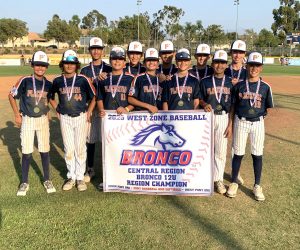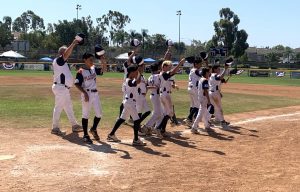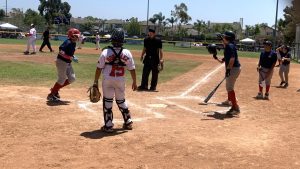CIF Southern Southern Commissioner Rob Wigod talked with OC Sports Zone in a Zoom interview this week. (Photo courtesy CIF Southern Section)
CIF Commissioner Rob Wigod believes it’s critical that there be a “unified front” for student athletes to help with the return of high school athletics after introducing a new plan which calls for two seasons of sports beginning in December 2020 in response to the coronavirus pandemic.
Football, which normally starts in August, would start on Jan. 8, 2021 if students are allowed to return to schools. The plan was introduced Monday by Wigod during a press conference.
“I really hope that we as adults keep our messages going forward in a positive way so our student athletes see how much we want to do this in service to them and then we can all look back on this and say, ‘look what we were able to accomplish and we were able to fight through and overcome’ and really do make this happen and get back to what we were we’re used to hopefully in the 2021-22 school year,” Wigod said in an interview with OC Sports Zone Tuesday.
Here are the major excerpts from the interview, which was conducted on Zoom.
What has been the reaction so far to the new plan?
Wigod: I think the positive reactions have come forward. Certainly, there were a lot of people who were speculating what was going to happen and some of those speculations were involving the cancellation of sports or severe reductions in the regular seasons or….. potentially only league champions were going to be allowed to advance to playoffs so I think there were some people in looking forward to what they thought might happen, there was some excitement and maybe some relief that some of the worst case scenarios they had in mind were not what we ended up releasing yesterday. And there are people who believed we could have done it differently, that there are too many sports in the spring or we maybe shouldn’t have had some sports with both genders in the same season. But we’ve gotten a lot of thanks and a lot of people appreciating that we’ve tried to provide some leadership here. All in all, I’ve been very busy in the last couple of days but I’ve felt pretty good about the way the reactions have come back.
What do you see as the major challenges in implementing this plan?
Wigod: The biggest challenge of all is that we can get our students back on campus and have them back in school for academics and when that happens, then we can certainly look for athletic programs to return. That’s first and foremost. All the plans and preparations are not going to be very meaningful if we are not able to restore some sense of confidence in a semi normal experience of getting students back on campus first. Beyond that, there are scheduling issues with coaches, with school facilities, with student athletes who wish to participate in multiple sports, our officiating will be challenged as well to make sure there is coverage for all the officials who are needed for contests. They are important details, but I believe those are details that we can overcome.
Talk about the waiver allowing athletes to compete on both high school and club teams in the same season:
Wigod: This is a state-wide by-law and CIF Executive Director Ron Nocetti is the one who has the ability to waive state-wide bylaws and it was the feeling that we were changing our seasons so dramatically that it wouldn’t be realistic for our student athletes who are involved in outside activities and club and travel teams that it wouldn’t realistic they wouldn’t be participating with those organizations as well. We’re the ones who changed the seasons and we just felt that wouldn’t be fair to our student athletes if they were forced to have to choose one or the other when we have changed the season. We hope that’s not the case now. Many of our high school coaches do coach in club activities so they would have the ability to allow both organizations to work.
If some districts are cleared to return to campus before others, how will that work. Do they all have to be cleared?
Wigod: No they don’t. And as we’ve talked about pretty consistently, these decisions about coming back to school and then allowing athletic teams back are going to be individual schools and school districts and private schools who make those decisions obviously following guidelines of state and local health authorities. We have established our calendar. We have determined when we believe these are the times we can conduct our championships and have our regular seasons. We will be ready to go with those who are ready to go with us. If there are those who haven’t been able to make those decisions to bring those teams back, we will respect those and certainly understand why they aren’t able to perhaps join us. But I don’t believe we are going to hold anybody to a threshold like that or say anything about a certain level. I think we’re going to try and go forward with whoever is able to go forward.
It seems like every district is about in the same boat?
Wigod: They are now, it wasn’t quite like that in a lot of our discussions earlier. For the seven counties contained within the Southern Section footprint, we’re all pretty much in the same boat now. It may not have started out that way a couple months ago.
One Santa Ana high school athletic director is concerned about staffing and facilities and considering he may have to drop some sports or levels. Can teams from one league drop out?
Wigod: That could be potentially possible and obviously we hope that isn’t the case. But we know we made some pretty big changes here and some sports, I’ve been calling them stacked sports in the spring where some students who are able to play basketball and run track or soccer and track or basketball/baseball or soccer/softball for girls. It’s not going to be normally possible in the way it’s normally been. People are not always aware though there is no by-law that prohibiting students from participating in two sports during the same season.
Some of these schools have fewer facilities and smaller budgets which presents a challenge:
Wigod: There’s no question about that. I think we are all doing the same thing and I think we can all agree we are trying to focus on our student athletes and trying to provide as many opportunities to them as we can, that’s why we wanted to have full regular seasons, we wanted to have the full ability for section championships, we wanted to have the opportunities for them that they’re used to. We understand there will be some schools and some districts and private schools too that may have to eliminate a level or unfortunately even drop a program. We know our smaller schools are going to be affected by this tremendously. But at the end of the day, the alternative was just to cancel and I’ve tried to make it clear that we realized fairly recently there really wasn’t an opportunity to have any fall sports in the traditional fall window.
Three weeks ago, we were still considering certain sports, girls golf, girls tennis, maybe girls volleyball, maybe even cross country. We were thinking maybe there was a viable way to have some fall sports in the traditional window but that has just gotten away from us and once that happened, we had to move into the two seasons model that we’ve come forward with. We realize that was going to have an affect on some things going forward and we hope we can stay with it and try our best to keep things going forward. We just have to go with our best foot forward and do everything we can to try and provide as much as we can for the student athletes.
Any advice for schools who have smaller budgets and have lost events which have been major fund-raisers?
Wigod: It’s going to be a major challenge. I would like to believe we’ve tried to help a little bit. These tournaments that schools are so used to can still take place in the months ahead. Under summertime rules, there is a maximum flexibility there where schools can still do off-season activities and things they may be used to doing in the regular season, they can still do. We hope some of those that conduct tournaments as fund-raisers will still be able to do it with health and safety first and that will be a way for them to help with raising money like they’re kind of used to doing. But there’s no doubt that’s going to be very, very difficult and no one can understate what’s in front of us. But if we are all committed and trying our best, that’s all that we can do. And I know that’s what we’re going to do and I’m really depending on our education leaders, our professionals, our principals, athletic directors and coaches, we’re depending on all of them to really keep that in mind and I believe they will and we can hopefully weather this difficult time for better days ahead.
Some people were surprised about having a full schedule for sports; what was thinking behind that?
Wigod: I think with the three seasons of sports models, we were looking at more of a drastic cut into regular seasons. We were looking at probably a 30 percent reduction in the regular seasons …. Most of our playoffs include about 60 percent of our membership in those particular sports, so a lot of them do get the opportunity to go to the playoffs and people were concerned that we would only limit entries from leagues to maybe league champions only, so second place and third place teams weren’t going to get an opportunity and the seasons reduced 30 percent. There was a way to do this in a much different way over the three seasons, but once the three seasons plan kind of went away, I think we then kind of thought …. if we are going to go to two seasons, then we can potentially provide enough overlap. We wanted to make sure cross country and track athletes had an overlap that would work. It had to work for swimming and water polo. It had to work for volleyball and basketball. It had to work for football and track. It had to work for football and wrestling. For some of those major dual sport situations, we really knew that with the two seasons of sport model, we were really going to be able to facilitate that a lot better than over three seasons. We knew that would be one part of this that would be perceived pretty well.
Any concerns about having enough officials, especially in water polo where they often work both boys and girls matches?
Wigod: Of course and we have official shortages across our section. There’s been a tremendous issue with that over the last couple of years for sure in a lot of sports. Maybe one good thing about water polo (in regards to the new plan) is the games don’t take all that long. They’re about an hour long. So the ability to play two, three or four water polo games at the same site was something that is probably very workable. so we would have a boys junior varsity, boys varsity, then girls varsity, then girls junior varsity at one site and be able to have officials there and have the lower levels maybe at the opponents site. That way we could maximize the use of our officials and be able to get officiating covered. There is a side of this in economic difficulties and when those have happened, we’ve seen an uptick in officials and seen more people coming out to get involved when the economy takes some hits. So we may see some of that. If our schools could just identify one potential official from one of their recent graduating classes or a student athlete who is in a junior college or a four-year college and is still around in the community; if every school came up with one young man or young woman to join our officiating ranks, that’s 500 new officials and we need new officials, we need young officials.
So the plan you have in place will go until December and then you wlll evaluate?
Wigod: We’re going to have to continually monitor what is happening in our counties with our state and local health authorities. It’s going to be a process that you are going to see play out. How are our schools doing with opening campuses for academics? Where are we with that? Then our schools have to make those decisions on opening up academically in whatever format that is, when they feel it is appropriate to bring their athletic teams back. When that happens, obviously we would know if our athletic seasons that we published yesterday can take place. As I said yesterday, I think we can go on with that on to November and into December and see where we are. If we still find we aren’t able to fit this calendar we could still push into January. We would still lose a little bit of regular season for sports that would have already scheduled games, our football teams would have to start acclimating in January but then start playing at the end of the month.
And then they would have reduced seasons, but we could still try to keep our viable league play going and if January became the month where we had to get started, as long as we had viable league play, then we could proceed with section championships. If there became a point in January where we just ran out of time and viable league play wouldn’t be possible, then we would have to unfortunately look at cancelling the fall sports and then we would shift our focus into spring. And that would be kicking in some as early as late February, but most would start in early March or middle of March, same process. We get to that time, see where we are with our schools, are they bringing their teams back and by the first part of April, again would be the time limit on viable league play. If we found ourselves the first week of April without the ability for viable league play to happen, then we would have to cancel at that point.
What we tried to do with this calendar, we didn’t want to say we can’t make the fall calendar happen, so we will get back to you in six weeks with a different calendar going forward. We wanted to say if we couldn’t make the fall calendar we had originally couldn’t happen, then we needed to come back with a firm calendar and plan going forward that we could stick with. I truly believe we can stick with this thing for six, seven maybe eight months totally before this entire sports year would get wiped out. We certainly hope that’s not where we go. But that’s how this should play out over the time we have in front of us.
So viable league play is critical?
Wigod: It is. We believe that if you’re going to have any kind of section championships and anything beyond it. People have talked about that, let’s have regular season only, I get that. I just felt when we got to the two season model, I thought we could do better, for our student athletes I thought we could offer them more. I thought we could give them full regular seasons and then give schools the opportunities to compete for championships.
Could some school districts bring sports back with on-line courses or does it have to be in person?
Wigod: That’s a really interesting scenario and it still comes back to the schools and their decisions. The schools looking at a 2,000 student body and not feeling comfortable yet with bringing 2,000 students back on campus, ironically if they brought their student athletes back, that would be a controlled environment with much fewer students and depending on what testing is and what kind of protocols were in place, theoretically it would be safer in that environment vs. when you have 2,000 students on campus. All options are on the table, but they would have to be the ones to decide that. It might be an interesting dynamic.
Would it be possible for fans to socially distance at football games rather than ban all fans?
Wigod: I think that’s possible. I think it’s possible to do that in a gymnasium. It’s possible to do that on a pool deck. It’s possible to do that at a tennis match. Again, it would come under those who are administering those contests at the schools local and state authorities are the ones who are going to determine whether a particular county or area is going to be able to do that and if so, our schools will still have the ultimate decision on how they are going to do that, who they want to admit, how they want to separate people who come out to watch.
-Tim Burt, OC Sports Zone; timburt@ocsportszone.com






More Stories
Placentia Bronco achieves final goal at regional with decisive win in championship
Olive Orange Bronco captures win over Santa Ana, secures berth in super regional
PHOTOS: Placentia Bronco squad earns spot in regional final, qualifies for next tourney